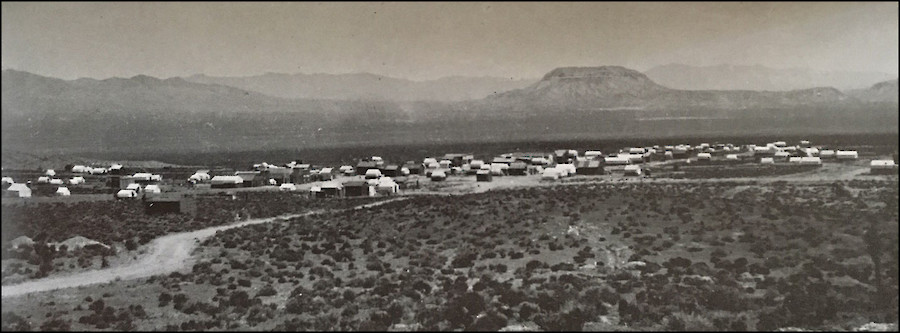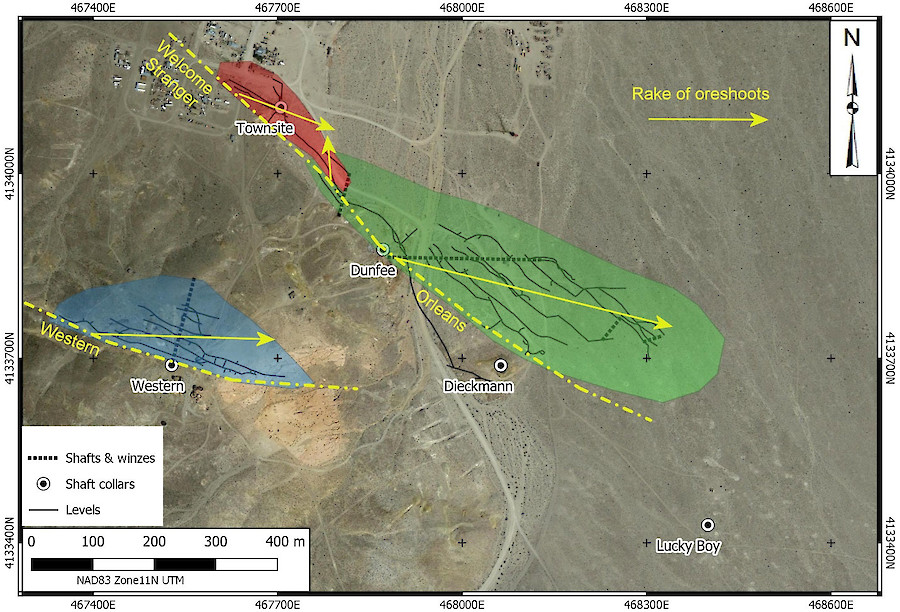Under Option to GGL Resources Corp. announced July, 29 2020
Gold Point is a high-grade gold and silver mining district, about 26 miles south of Goldfield and 43 miles northwest of Beatty. The district was discovered in 1868 and became known as Hornsilver following the discovery of bonanza grade chlorargyrite in 1908. As mining progressed to depth, gold predominated and the district was renamed Gold Point in the 1930’s. Underground mining of higher-grade portions of the veins in the district occurred intermittently between 1882 and 1962. The last operation ceased with the closure of their mill at Silver Peak. Total historic production to date in the district has been estimated at approximately 74,000 oz gold equivalent, silver being included in earlier production records.
Gold Point, 1908 (Paher, 1972)
The Gold Point area is underlain by Precambrian Wyman Formation fine-bedded clastics and carbonates and by Reed Dolomite, intruded and tilted to the NE by an ESE trending finger of the Jurassic Sylvania Pluton. Precious metal mineralization is hosted in branching and anastomosing WNW striking, moderately NNE dipping veins and breccias in the Wyman Formation. Ore shoots within these systems dominantly rake to the east in the plane of the structures. The host veins consist of crushed, coarse crystalline quartz with hematite and limonite. Silver mineralization is shallow and hosted in chlorargyrite and rare bromyrite. Gold is associated with pyrite, galena and cerussite, persisting to a depth of at least 1,020’ below ground level. The principal veins in the Gold Point area are the Grand Central – Western vein system and the Welcome Stranger (Townsite) – Orleans vein system to the northeast. The veins range up to 9 m in width (Orleans Veins) and the major vein systems were defined on strike at surface for nearly a kilometer.
Mineralization at Gold Point is mesothermal and either orogenic or intrusion related. Gold Point mineralization is similar in style, mineralogy and stratigraphic position to Scorpio Gold Corporation’s Mineral Ridge Deposit (Production to 2018: 697,715 oz Au) and to Valterra Resource Corporation’s Weepah Deposit (117,000 oz Au past production), both north of the property.
Gold Point area showing main veins, workings and ore shoots.
Silver Range’s East Gold Point Property covers the structural and stratigraphic extension of the main workings and mineralization at Gold Point to the southeast over a distance of 2.25 km. Silver Range acquired the property by purchase and staking in 2019. Historic exploration in the East Gold Point Property area was frustrated by relatively thick overburden but the region was nonetheless a major focus of attention during development in the 1930’s. The nearby Dieckmann Shaft and workings connecting to the Dunfee Shaft in particular were driven by a theory that the Orleans vein branched from potentially rich and thicker vein southeast of the exposed and exploited veins. Historic workings on the East Gold Point Property include two shafts with limited drifting (Lucky Boy and Hornsilver America shafts). Initial underground sampling at the Hornsilver America workings returned up to 13.7 g/t Au from grab samples and 1.2 m @ 2.65 g/t Au from chip samples.
In early 2020, Silver Range forged an alliance with Nevada Rand LLC (“Nevada Rand”) to consolidate the major past producing mines and prospects in the Gold Point district. Nevada Rand is a family-owned, underground mining contracting firm, well experienced in narrow vein high grading operations. Since the 1990’s, they have acquired historic data and consolidated claim holdings covering the Great Western and Orleans veins and most of the Townsite / Welcome Stranger Vein. Silver Range’s East Gold Point project is southeast of Nevada Rand’s claims and covers the inferred eastern extension of the structural corridor hosting the gold bearing veins at Gold Point. The Lucky Boy shaft on the East Gold Point Property was sunk where float containing visible gold was found and the Hornsilver America shaft, approximately 1.6 km to the southeast, hosts gold bearing veins which returned up to 13.8 g/t Au in recent sampling. Silver Range and Nevada Rand staked and jointly own buffer claims between their respective land positions, covering all the favourable ground in the area.


